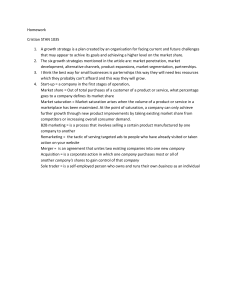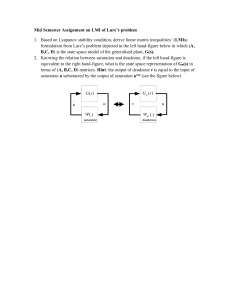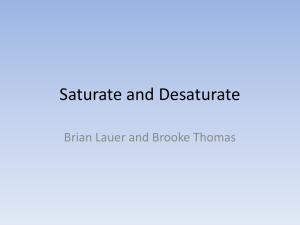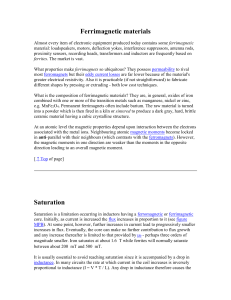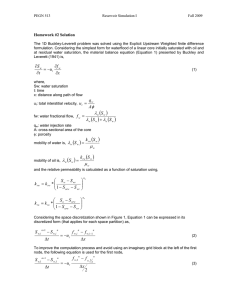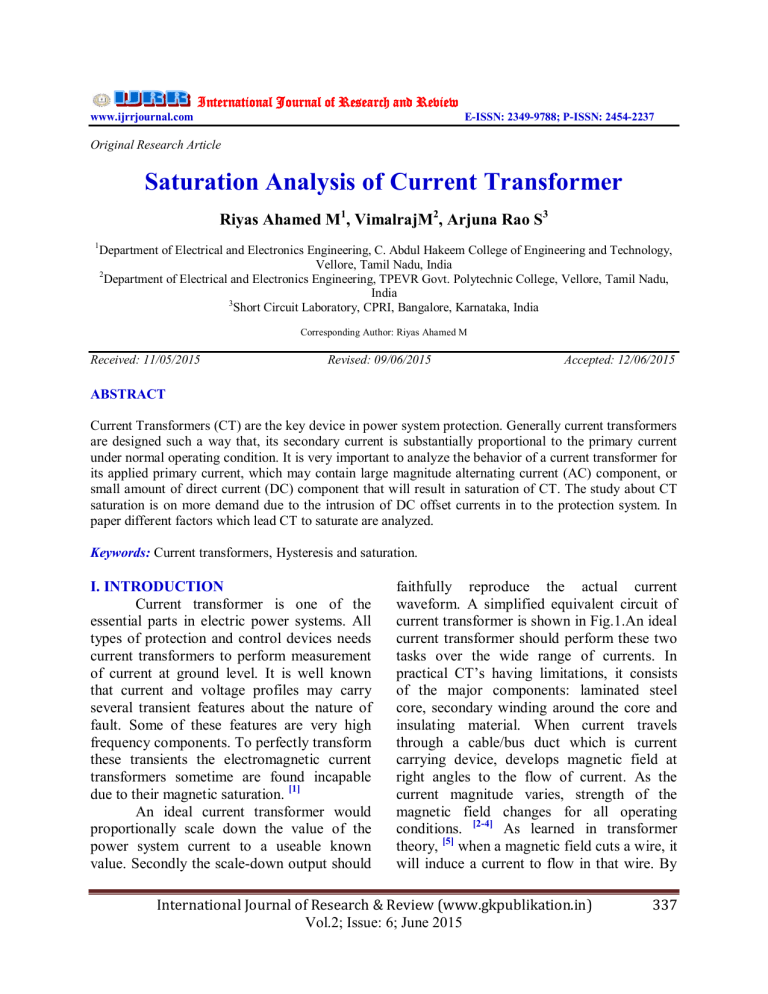
International Journal of Research and Review www.ijrrjournal.com E-ISSN: 2349-9788; P-ISSN: 2454-2237 Original Research Article Saturation Analysis of Current Transformer Riyas Ahamed M1, VimalrajM2, Arjuna Rao S3 1 Department of Electrical and Electronics Engineering, C. Abdul Hakeem College of Engineering and Technology, Vellore, Tamil Nadu, India 2 Department of Electrical and Electronics Engineering, TPEVR Govt. Polytechnic College, Vellore, Tamil Nadu, India 3 Short Circuit Laboratory, CPRI, Bangalore, Karnataka, India Corresponding Author: Riyas Ahamed M Received: 11/05/2015 Revised: 09/06/2015 Accepted: 12/06/2015 ABSTRACT Current Transformers (CT) are the key device in power system protection. Generally current transformers are designed such a way that, its secondary current is substantially proportional to the primary current under normal operating condition. It is very important to analyze the behavior of a current transformer for its applied primary current, which may contain large magnitude alternating current (AC) component, or small amount of direct current (DC) component that will result in saturation of CT. The study about CT saturation is on more demand due to the intrusion of DC offset currents in to the protection system. In paper different factors which lead CT to saturate are analyzed. Keywords: Current transformers, Hysteresis and saturation. I. INTRODUCTION Current transformer is one of the essential parts in electric power systems. All types of protection and control devices needs current transformers to perform measurement of current at ground level. It is well known that current and voltage profiles may carry several transient features about the nature of fault. Some of these features are very high frequency components. To perfectly transform these transients the electromagnetic current transformers sometime are found incapable due to their magnetic saturation. [1] An ideal current transformer would proportionally scale down the value of the power system current to a useable known value. Secondly the scale-down output should faithfully reproduce the actual current waveform. A simplified equivalent circuit of current transformer is shown in Fig.1.An ideal current transformer should perform these two tasks over the wide range of currents. In practical CT’s having limitations, it consists of the major components: laminated steel core, secondary winding around the core and insulating material. When current travels through a cable/bus duct which is current carrying device, develops magnetic field at right angles to the flow of current. As the current magnitude varies, strength of the magnetic field changes for all operating conditions. [2-4] As learned in transformer theory, [5] when a magnetic field cuts a wire, it will induce a current to flow in that wire. By International Journal of Research & Review (www.gkpublikation.in) Vol.2; Issue: 6; June 2015 337 using the strength of the magnetic field and knowing the turns ratio we can obtain a value of current that is useable for meters, relays and other current sensing device. In order to scale a value of high current flowing in a conductor, the engineer needs to introduce a specific number of uniformly distributed turns of wire around the core to scale down the system current. This will ensure that the output current is always proportional to the current flowing in the conductor. In the past, there were two main values of secondary current typically used in measuring current. In the United States, engineers typically use a 5amp output and other countries have adopted a 1-amp output. In the advent of microprocessor meters and relays, the industry is seeing the 5-amp or 1-amp secondary being replaced with a mA secondary. Typically, devices with mA output are called “current sensors,” as opposed to current transformers. the rated current. But protection and PS class CT’s can be operated for a wide range of rated current. [6] When the secondary induced EMF passes the level of knee point voltage (V K) shown in fig. 2, the core goes for saturation. Measurement class CT’s can’t operate beyond the knee point, but the protection and PS class CT’s can operate around the knee point depends on the class of CT. Abnormal high magnitude primary current and high secondary burden these two results high flux density in the current transformer core. When the flux density reaches the designed limit of the core it results saturation. [7] Fig.3 shows the result of saturation, the CT accuracy becomes poor, the secondary side output waveform becomes distorted; also the magnitude of secondary wave reduces due to core impedance. Fig. 2 Secondary excitation curve representing knee-point Fig. 1 Simplified equivalent circuit of CT CT saturation is a term used to describe the state where a CT is no longer able to reproduce an output current in proportional to its primary current or as per its ratio. [6] The basic reason for CT saturation is due to number of reasons like large primary current, small DC current, high burden at the secondary and open circuit in the secondary. II. CONCEPTS OF CURRENT TRANSFORMER SATURATION The saturation is the concept related to property of magnetic materials used for the current transformer core. In usual the metering CT’s core saturates for smaller multiples of Fig. 3 CT current waveforms due to saturation CT saturation depends on number of factors: Physical CT characteristics (size, rating, winding resistance, saturation voltage) Connected CT secondary burden (wires with relay/meter/protective equipment’s) International Journal of Research & Review (www.gkpublikation.in) Vol.2; Issue: 6; June 2015 338 Primary current magnitude, DC offset (system X/R) Residual flux in the core. 2.1 Saturation due to large magnitude of current (AC saturation) Large magnitude of primary current (symmetrical in nature) during fault condition can cause the saturation to the CT core. [8] Current with higher magnitude of the rated primary current (about 20 times of the rated value) can cause saturation. This level can be adjusted by choosing the knee point voltage of the core. Fig. 4 shows the core saturation due to larger magnitude of primary current. 2.2 Saturation due to DC offset Presence of DC offset in fault current is the causes of saturation in current transformer core. [8] This will be more pronounced if the X/R ratio of the system up to the fault location is considerably high. Fig. 5 shows the CT core saturation due to DC offset. Fig. 4 CT core saturation due to large primary current Fig. 5 CT core saturation due to DC offset If the saturation level is reached the magnetizing current will strongly increase. The CT needs all current for magnetizing and no current is left for the secondary side. The secondary current will be strongly distorted and the error will be considerable. Fig. 4 shows secondary currents for some examples of saturation due to large primary AC current and fig. 5 shows an example of CT saturation with DC offset. [1,3-4] The current is reproduced correctly up to the level where the core starts to saturate but during the periods the core is saturated the secondary current practically disappears. Saturation will cause both amplitude and phase errors. The fundamental current component amplitude will be reduced and the phase will be advanced. Remanence The DC component decays with a time constant L1/R1 as mentioned. The flux level in the core will not go to zero till the DC component dies-out. The steady state flux variation will not reduce the flux to zero; if any other fault occurs the flux excursion will start at “remanence flux” (residual flux). Remanence or remaining flux in the CT core influences the time to saturation. [9] When there is no DC offset the remanence will only affect the first half cycle of the current waveform. If the fault current has a DC offset, the remanence will just impact the first moment when the CT will saturate and the time to saturation can be decreased. The saturated secondary current has the same characteristics as for DC saturation without any remanence. III. REMEDIES TO OVERCOME SATURATION The event of transient leads the current transformer core to partial or severe saturation. The effect of saturation are can be reduced, also in some cases we can overcome it; by taking corresponding remedial actions. International Journal of Research & Review (www.gkpublikation.in) Vol.2; Issue: 6; June 2015 339 The remedies which can overcome the saturation are follows. 3.1 CT oversizing factor and residual flux Current transformer core saturation can be avoided on DC components by over sizing the core. The core can be designed as the DC flux is oversized at corresponding flux density. In normal, the flux (∅) carries both AC and DC components 𝐦𝐚𝐱 ∅𝐦𝐚𝐱 = ∅𝐦𝐚𝐱 𝐀𝐂 + ∅𝐃𝐂 The factor max ∅max AC +∅DC ∅max AC is called as oversizing It is possible to calculate the time to saturate for any CT given the set of saturation voltage, remanence level, details of connected burden etc. Fig. 6 shows the saturation time curve of CT once the time to saturation is known a quick check against the time of operation of the protective relay would indicate whether the application would function properly with respect to the CT characteristics. Special care is needed when high speed auto reclose is concerned since the remanence magnetism and the CT secondary transient effects are the maximum when a reclose is attempted with a permanent fault on the line. factor. The core oversizing factor = 1 + ωt ; =1+ =1+ ωL line R line ∅max = + ∅DC max ; AC X1 R1 In order to design CT which will always reproduce current accurately it is necessary to 𝐗 𝟏+ 𝟏 increase the CT size by the term, 𝐑𝟏 𝟏−𝛙 . Where 𝛙 is the per unit maximum flux remaining in the core after removal of the primary current. In practice high amount of over sizing is not possible. Residual flux During faults, if the remanence-flux direction is opposite to that of the DC current component the CT will produce correct secondary waveform. On the contrary, if the remanence flux and the DC transient occur in the same direction, a more distorted waveform than usual occurs. Various methods are used to reduce the effects of remanence. [9] Using different grades of steel for the core Gapped core Biased core CTs. 3.2 Time to saturate CT core Fig.6 Saturation time curve for CT 3.3 Impact of Secondary burden Increase in secondary winding circuit burden means an increase in volt ampere rating. [10] This necessitates an increase in secondary winding induced voltage. Increase in secondary winding induced voltage can be done by increased flux & flux density. Fig. 7 shows that the secondary current is purely sinusoidal for burden of 0.3 ohms. If the same CT is connected to a burden of 100 ohms the secondary current wave gets distorted. 3.4 Impact of X/R ratio Mainly speaks about the parameters on primary side of CT, X/R is responsible for the decaying DC component. DC component produces constant magnetic flux contributes to CT saturation. Since X/R ratio cannot be altered for the power protection purpose it can International Journal of Research & Review (www.gkpublikation.in) Vol.2; Issue: 6; June 2015 340 only be suggested that the described phenomenon should be carefully taken under consideration when choosing a CT. In fig. 8, clears that more X/R ratio makes the distorted secondary current waveform even at smaller magnitude. Fig. 7 Secondary current wave with various burden values Fig. 8 Impact of X/R ratio over CT saturation IV. CONCLUSION The concept, causes and remedies of saturation makes it clear that: Consequences of CT saturation are the secondary current will not faithfully replicate the primary current, secondary current is clipped and this clipping of CT current leads to blinding of the protection system. The saturation can be caused due to large primary AC currents or smaller magnitude DC offset. The remedies to overcome saturation clears that, it requires more care while choosing the designing parameters (includes burden). REFERENCES 1. Bahram Noshad, Babak Fakhar, Mina Goodarzi.” A new model for current transformer”, Journal of Basic and Applied Scientific Research, Vol. 3, No.2, pp.738-744, 2013. 2. Davarpanah M, Sanaye-Pasand M, Iravani R. “A saturation suppression approach for the current transformer Part I: fundamental concepts and design”, IEEE Transactions on Power Delivery, Vol. 28, No. 3, pp.1928-1935, 2013. 3. Rafajdus P, Bracinik P, Hrabovcova V, Saitz J, Kankula L. “Current transformer analysis under transient conditions”, XIX International Conference on Electrical Machines - ICEM 2010, Rome, 2010. 4. Pandey R. P, Patel R. N. “An efficient detection algorithm for ct saturation using linear predictive coding”, International Journal of Engineering Development and Research, Vol. 2, No. 2, pp.1648-1652, 2014. 5. Brain D Jenkins, “Introduction to Instrument-Transformers” George Newnes Limited, London, 1967. International Journal of Research & Review (www.gkpublikation.in) Vol.2; Issue: 6; June 2015 341 6. Longfei Ren, Zhiguo Hao, Baohui Zhang. “A novel algorithm applied in the transient saturation of current transformer”, TENCON 2013 - 2013 IEEE Region 10 Conference (31194), pp. 1-4, 2013. 7. Chi-Shan Yu. “Detection and correction of saturated current transformer measurements using decaying dc components”, IEEE Transactions on Power Delivery, Vol. 25, No.3, pp.13401347, 2010. 8. Juan A. Martinez-Velasco, “Power System Transients Parameter Determination” CRC Press, New York, 2010 9. Shirkovets A.I. “Modeling of transient processes at ground faults in the electrical network with a high content of harmonics”, 2nd International Conference on Electric Power Equipment - Switching Technology (ICEPE-ST), 2013,pp.1-5, 2013. 10. Davarpanah M, Sanaye-Pasand M, Iravani R. “A saturation suppression approach for the current transformer— Part II: fundamental concepts and design”, IEEE Transactions on Power Delivery, Vol. 28, No. 3, pp.1936-1942, 2013. BIOGRAPHIES Mr. M. Riyas Ahamed received his Diploma (EEE) from TPEVR Govt. Polytechnic, Vellore (TN), India in 2007 and B.E (Electrical & Electronics Engineering) from CAHCET, Vellore (TN), India in 2010. He completed his M.E in Power Systems Engg. in 2014 From Kingston Engineering College, Vellore (TN), India. Currently he is working as Assistant Professor in C. Abdul Hakeem College of Engineering and Technology, Melvisharam, Vellore. He is a reviewer for International Journal of Electric Power and Energy Systems. His areas of interest are in Optimization problems, FACTS, Transient response of power system and transformers, Renewable Energy Resources and Micro grid. Mr. M. Vimalraj received B.E (Electrical & Electronics Engineering) from Ganadipathy Tulsi’s Jain Engg College, Vellore (TN), India in 2011 and he is currently a PG student in Power Systems Engg from Kingston Engg College, Vellore (TN), India. He has been working in teaching field. Areas of interest are including Renewable Energy Resources, Electrical machines, FACTS, Soft Computing and Stability and control of power systems. Mr. Somala Arjuna Rao, Obtained B.Tech (EEE) from Nagarjuna University, Guntur, AP, M.Tech (Power Systems) from NIT Tiruchy, TN and M.B.A from Bangalore University, Karnataka. For the past more than five years he is holding the post of engineering officer in CPRI. His areas of Interests areas are Short Circuit Studies, Failure Analysis of Instrument Transformers & LV switchgear. How to cite this article: Ahamed MR, Vimalraj M, Rao SA. Saturation analysis of current transformer. Int J Res Rev. 2015; 2(6):337-342. ************** International Journal of Research & Review (www.gkpublication.in) Vol.2; Issue: 6; June 2015 342
